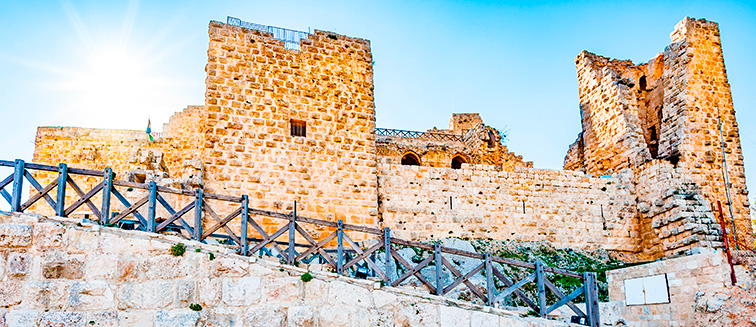Jordan Day & Tour For Tourism Marketing
Jordan Day & Tour For Tourism Marketing
Ajloun Castle
we recommend you Add Jerash or/and Umm Qais.
Start at 7:00 AM will help more to visit all these sites.

Ajloun is located 73 km north of Amman, the northwest of Jerash.
around 90 Minute Drive from Amman & 30 Minute From Jerash.
Ajloun Castle Another Name (Qalʻat ar-Rabad), is a 12th-century Muslim
the castle situated in northwestern Jordan. It is placed on a hilltop belonging to the Mount Ajloun district,
also known as Jabal ‘Auf after a Bedouin tribe that had captured the area in the 12th century. From its high ground, the castle was guarding three wadis that descend towards the Jordan Valley. It was built by the Ayyubids in the 12th century and enlarged by the Mamluks in the 13th. The name ‘Ajlun goes back to a Christian monk who lived on this mountain in the Byzantine period. The castle stands on the ruins of a monastery, traces of which were discovered during archaeological excavations. The castle has been the nucleus of a settlement that has grown to become the present town of Ajloun.
Winter (November through April)
8:00 am – 4:00 pm
Summer
8:00 am – 6:30 pm
April and May
8:00 am – 5:30 pm
The Holy month of Ramadan
8:00 am – 3:30 pm
3 JD (4.25 USD) Includes the museum entrance fees.
Ajloun Castle Entrance Fee included in
Amman to Ajloun Castle around 90 Minutes.
Jerash To Ajloun Castle around 30 Minutes.
Ajloun Castle to Umm Qais around 60 Minutes.
Within Ajloun (Qal’ at Ar-Rabad), a small, but interesting museum the Archaeological Museum (founded in 1993) and it exhibits an extensive, excavated collection of:
pottery.
ceramics.
glass bottles.
stone tools.
metalwork.
coins.
fragments of buildings with intricate drawings and inscriptions.
and other artefacts dating from 1000 BC to 1918 AD.
Anyone visiting Ajloun Castle should visit the museum to have a much better understanding of:
the Great Salah al-Din Al Ayyubi.
the history of the Castle.
and, Also the people who lived in it and around it through thousands of years.
Ajlun Castle is located on the site of an old monastery.
It was renovated as a fort in 1184 by Izz al-Din Usama, a general in the army of Saladin.
The castle controlled traffic along the road connecting Damascus and Egypt.
According to Saladin’s historian Baha ad-Din ibn Shaddad, the fortress was primarily built to help the authorities in Damascus control the Bedouin tribes of the Jabal ‘Auf.
These enjoyed enough autonomy to ally themselves to the Crusaders and had at one point set up a 100-tent camp next to the Hospitaller castle of Belvoir on the opposite side of the Jordan Valley.
As such, Ajlun Castle is one of the very few Muslim fortresses built by the Ayyubids to protect their realm against Crusader incursions, which could come from Beisan or Belvoir in the west and Karak in the south.
The fortress dominated a wide stretch of the northern Jordan Valley from its location, controlled the three main passages that led to it (Wadi Kufranjah, Wadi Rajeb and Wadi al-Yabis), and protected the communication routes between south Jordan and Syria.
It was built to contain the progress of the Latin Kingdom, which with the Lordship of Oultrejourdain had gained a foothold in Transjordan, and as a retort to the castle of Belvoir a few miles south of the Sea of Galilee.
Another major objective of the fortress was to protect the development and control of the iron mines of Ajlun.
The original castle had four corner towers connected by curtain walls and a double gate.
Arrow slits were incorporated in the thick walls and it was surrounded by a moat averaging 16 meters (about 52 feet) in width and 12–15 meters (about 40–50 feet) in depth.
After Usama’s death, the castle was enlarged in AD 1214–15 by Aibak ibn Abdullah, the Mamluk governor.
He added a new tower in the southeast corner and built the gate.
The castle lost its military importance after the fall of Karak in AD 1187 to the Ayyubids.
In the middle of the 13th century AD, the castle was conceded to Yousef ibn Ayoub, King of Aleppo and Damascus, who restored the northeastern tower and used the castle as an administrative centre.
In 1260 AD, the Mongols destroyed sections of the castle, including its battlements. Soon after the victory of the Mamluks over the Mongols at Ain Jalut, Sultan ad-Dhaher Baibars restored the castle and cleared the fosse.
The castle was used as a storehouse for crops and provisions. When Izz ad-Din Aibak was appointed governor, he renovated the castle as indicated by an inscription found in the castle’s south-western tower.
During the Ottoman period, a contingent of fifty soldiers was set inside the castle.
During the first quarter of the 17th century, Prince Fakhr ad-Din al-Mani II used it during his fight against Ahmad ibn Tarbay. He supplied the castle with a contingent and provided provisions and ammunition.
In 1812, the Swiss traveller Johann Ludwig Burckhardt found the castle inhabited by around forty people.
Two major destructive earthquakes struck the castle in 1837 and 1927.
Recently, the Department of Antiquities of Jordan has sponsored a program of restoration and consolidation of the walls and has rebuilt the bridge over the fosse.
Ajlun Castle is open for tourism.
Many areas of the castle can be explored.
Tourists in Jordan often visit the castle.
Inside there is also a museum exhibition with many interesting artefacts from the various time periods of the region.